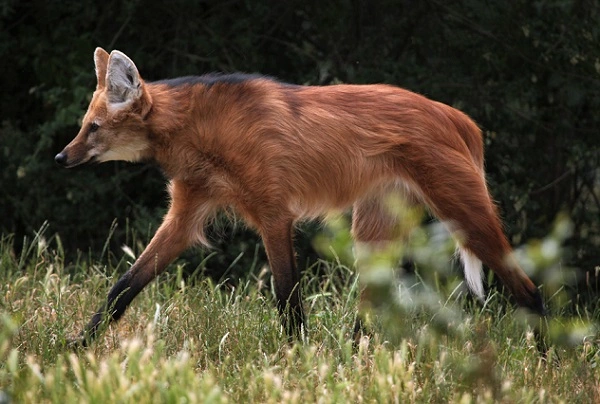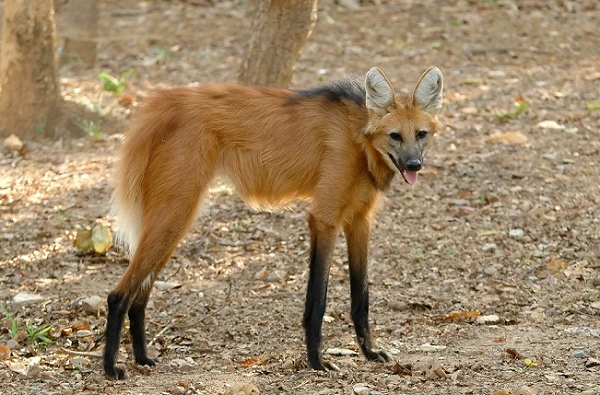The maned wolf is a fascinating creature. Nicknamed the “skunk fox,” this mammal is native to South America and has striking features that set it apart from other animals in the same family. In this post, we’ll take a closer look at the maned wolf, including its physical characteristics, diet, and habits. We’ll also explore why this animal is such an important part of the ecosystem and how humans are impacting its population. Stay tuned for more information on one of nature’s most unique creatures!

Maned Wolf Description
The Maned Wolf is a large canid native to South America. It is the tallest of the wild canids, and its long legs and distinctive red mane give it a striking appearance. The Maned Wolf is an opportunistic feeder, and its diet consists of rodents, rabbits, birds, reptiles, fruits, and insects. Although it is not considered a threat to livestock, the Maned Wolf will occasionally kill sheep or goats. The Maned Wolf is a social animal, living in pairs or small family groups. However, it is largely solitary in nature, avoiding contact with other members of its species. Maned Wolves are threatened by habitat loss and fragmentation, as well as persecution by humans. As a result, they are listed as Vulnerable on the IUCN Red List.
Maned Wolf Habitat
Maned Wolf habitat consists of open and semi-open areas in the subtropical regions of South America. The Maned Wolf is the largest canid of its range and prefers habitats with little human disturbance. However, due to habitat loss and fragmentation, Maned Wolves are forced to adapt to living in more urbanized areas. Maned Wolves are shy and reclusive by nature, but they have been known to approach people out of curiosity. They are most active at night, but they can also be seen during the day. Maned Wolves typically live alone or in pairs, but packs have been known to form in areas with abundant game. The Maned Wolf is an important part of the ecosystem, preying on rodents and other small mammals that could otherwise cause problems for farmers and ranchers. Maned Wolves also help to keep the populations of large predators such as pumas in check. Conservation efforts are underway to help protect Maned Wolf habitat and ensure the long-term survival of this unique species.
Maned Wolf Diet
The Maned Wolf is a special and unique creature found in South America. It is the largest canid of its region and sports a reddish coat with black legs and facial markings. One of the Maned Wolf’s most distinguishing characteristics is its long, fox-like snout. Though it may look like a fox, the Maned Wolf is actually more closely related to coyotes and dogs. The Maned Wolf’s diet consists primarily of rodents, rabbits, and insects. It will also eat fruit, carrion, and other small animals. In captivity, Maned Wolves have been known to eat vegetables, eggs, and even bread. The Maned Wolf is an important predator in its ecosystem, helping to maintain the balance of nature.

Maned Wolf Size
The Maned Wolf is the largest canid of South America. It is the only member of the genus Chrysocoyon. Its coat is reddish brown, and it has long, black legs and a black mane. The Maned Wolf is about the same size as a large dog. It weighs between 24 and 38 kg (53 and 84 lb). Males are larger than females. Maned Wolves are native to Brazil, Bolivia, Paraguay, Uruguay, and Argentina. They live in open areas such as grasslands, swamps, and forest edges. Maned Wolves are solitary animals. They mark their territory with urine. Maned Wolves are nocturnal animals. They hunt for food at night. Maned Wolves eat small mammals, insects, reptiles, and fruit. Maned Wolves are endangered animals. Their population has declined by 30% since the 1970s. The main threats to Maned Wolves are habitat loss and hunting.
Maned Wolf Lifespan
Maned Wolves are the largest canids in South America, with males reaching a shoulder height of about 90 cm (35 in) and females averaging 83 cm (33 in). They typically weigh 23–41 kg (51–90 lb), but occasionally exceed 50 kg (110 lb). The Maned Wolf’s coat is reddish-brown, while the hair on its muzzle, neck and legs is black. It has long, erect ears, and its mane is black. The Maned Wolf is endemic to the open grasslands of South America. Although it once occurred throughout the region, by 1970 it had been reduced to extremely small populations in Paraguay, Brazil and Argentina. Today, it occurs predominantly in protected areas in central Brazil, with a few individuals inhabiting Paraguay and northern Argentina. In addition to habitat loss, the Maned Wolf is threatened by persecution due to its resemblance to the Red Fox. It has a lifespan of about 11 years in the wild and up to 15 years in captivity. The Maned Wolf is an unusual canid because of its long limbs and red coat. It is classified as a subspecies of the Gray Wolf, but some researchers believe it should be considered its own species.
Maned Wolf Behavior
Maned Wolves are the largest canids in South America, and are easily recognizable due to their long legs and distinctive red fur. They are shy and solitary animals, typically only coming together to mate. Maned Wolves are mostly nocturnal, and will often hunt alone or in pairs. Their chief prey is medium-sized mammals such as deer, but they will also eat reptiles, birds, and insects. Maned Wolves have a very strong sense of smell, and will often urinate on trees and bushes to mark their territories. Although they are not considered endangered, Maned Wolf populations have been declining due to habitat loss and hunting. As a result, they are now protected by law in many countries.
With their striking appearance and solitary lifestyle, Maned Wolves are definitely one of the most fascinating animals in the world.
Maned Wolf Speed
Maned wolves are predominantly found in the forests of South America, but their range also extends into Central America. They are the tallest of the wild canids, and they get their name from the striking black mane that runs down their back. Maned wolves are shy and elusive creatures, and they are most active at dawn and dusk. Despite their size, they are actually quite fast, capable of reaching speeds of up to 40 miles per hour. They are also excellent jumpers, able to clear distances of up to 16 feet in a single bound. Maned wolves typically live alone or in pairs, and they rarely interact with other members of their species. However, they are not considered to be endangered, and their population is thought to be stable.
Maned Wolf Hunting
Maned wolves are unique animals that are found in South America. They are the largest canines in the region and have a reddish-brown coat with black legs. Maned wolves are also known for their long neck, mane, and bushy tail. The species is currently classified as near threatened by the IUCN. Maned wolves are hunted for their fur and body parts, which are used in traditional medicine. In addition, they compete with livestock for food, which can lead to conflict with farmers. Maned wolf populations have declined by as much as 30% over the past two decades due to hunting and habitat loss. As a result, it is important to take measures to protect this species. This includes creating protected areas and educating local communities about the importance of conservation.
Conclusion
The maned wolf is an interesting creature that has many adaptations to help it survive in its environment. As humans encroach more and more on the maned wolf’s territory, it will be important for us to understand this animal better and take steps to protect it. It would also be beneficial for us to learn from the maned wolf about ways we can reduce our own impact on the environment. What have you learned about the maned wolf that surprised or interested you?
Frequently Asked Question

